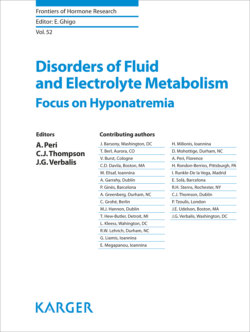Читать книгу Disorders of Fluid and Electrolyte Metabolism - Группа авторов - Страница 23
На сайте Литреса книга снята с продажи.
Tonicity Sensing Mechanisms
ОглавлениеIn view of the many clinical disorders brought about by water excess or deficit, the existence of a sensing mechanism for the prevention of these disorders is important. We lack water sensors to monitor changes in water balance. Instead, we have osmoreceptors. Osmoreceptors sense changes in plasma tonicity that deviate by as little as ∼3 mOsm/kg from the set point (280 mOsm/kg), triggering specific homeostatic responses to restore water balance. Osmoreceptors are localized in the central nervous system in the organum vasculosum of lamina terminalis (OVLT) which is located in the hypothalamus. This is a component of structures known collectively as the circumventricular organs, characterized by the absence of blood-brain barrier. This allows for direct contact with the ECF to readily sense minimal changes in its composition. OVLT neurons are mechanosensitive and tonicity-mediated changes in cell volume are directly coupled to their excitation or inhibition, OVLT neurons maintain their cell volume for hours as they must remain active for as long as the plasma tonicity is elevated. The excitation of OVLT neurons in response to cell shrinkage is mediated by the activation of non-selective cation current, which leads to depolarization and an increase in action potential firing rate. Conversely, the inhibition of these neurons in response to cell swelling, is mediated by the inhibition of non-selective cation current leading to hyperpolarization and to a decrease in action potential firing rate. The non-selective cation channel appears to be a truncated N-terminal variant of the transient receptor potential vanilloid type-1 [7].
Experimental evidence suggests the existence of additional peripheral osmoreceptors along the oropharyngeal cavity, gastrointestinal tract, splanchnic mesentery, portal vein, and liver. These osmoreceptors can detect the osmotic load of ingested materials generating action potentials carried by afferent vagal pathways to the central nervous system, providing an anticipatory response that might buffer the potential impact of foods with very high or very low tonicity [8].
